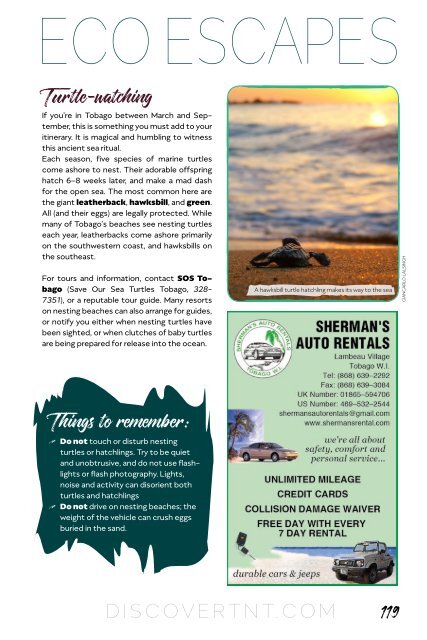Discover Trinidad & Tobago 2017 (#28)
Published every year since 1991, Discover T&T helps readers discover where to stay, dine, lime, party, and shop; and what to see (including the islands’ best sites) and experience (festivals, arts and culture, sports, and eco escapes), in both islands. There’s also a national calendar of events; info on getting here and getting around; tips for safe and sustainable travel; T&T history and society in a nutshell, maps; and more. For the second edition in the row, the magazine features a distinctive dual-cover design, with one cover for each island — Trinidad's Gasparee Caves (captured by Stephen Reyes) and a leatherback turtle hatchling in Tobago (captured by Giancarlo Lalsingh). Discover T&T is aimed at local and international explorers planning getaways to the islands — whether for an eco adventure, business trip, or beach holiday. For more: http://www.discovertnt.com • http://www.facebook.com/discovertnt
Published every year since 1991, Discover T&T helps readers discover where to stay, dine, lime, party, and shop; and what to see (including the islands’ best sites) and experience (festivals, arts and culture, sports, and eco escapes), in both islands. There’s also a national calendar of events; info on getting here and getting around; tips for safe and sustainable travel; T&T history and society in a nutshell, maps; and more.
For the second edition in the row, the magazine features a distinctive dual-cover design, with one cover for each island — Trinidad's Gasparee Caves (captured by Stephen Reyes) and a leatherback turtle hatchling in Tobago (captured by Giancarlo Lalsingh).
Discover T&T is aimed at local and international explorers planning getaways to the islands — whether for an eco adventure, business trip, or beach holiday. For more: http://www.discovertnt.com • http://www.facebook.com/discovertnt
- No tags were found...
Create successful ePaper yourself
Turn your PDF publications into a flip-book with our unique Google optimized e-Paper software.
eco escapes<br />
Turtle-watching<br />
If you’re in <strong>Tobago</strong> between March and September,<br />
this is something you must add to your<br />
itinerary. It is magical and humbling to witness<br />
this ancient sea ritual.<br />
Each season, five species of marine turtles<br />
come ashore to nest. Their adorable offspring<br />
hatch 6–8 weeks later, and make a mad dash<br />
for the open sea. The most common here are<br />
the giant leatherback, hawksbill, and green.<br />
All (and their eggs) are legally protected. While<br />
many of <strong>Tobago</strong>’s beaches see nesting turtles<br />
each year, leatherbacks come ashore primarily<br />
on the southwestern coast, and hawksbills on<br />
the southeast.<br />
For tours and information, contact SOS <strong>Tobago</strong><br />
(Save Our Sea Turtles <strong>Tobago</strong>, 328-<br />
7351), or a reputable tour guide. Many resorts<br />
on nesting beaches can also arrange for guides,<br />
or notify you either when nesting turtles have<br />
been sighted, or when clutches of baby turtles<br />
are being prepared for release into the ocean.<br />
A hawksbill turtle hatchling makes its way to the sea<br />
giancarlo lalsingh<br />
Things to remember:<br />
n Do not touch or disturb nesting<br />
turtles or hatchlings. Try to be quiet<br />
and unobtrusive, and do not use flashlights<br />
or flash photography. Lights,<br />
noise and activity can disorient both<br />
turtles and hatchlings<br />
n Do not drive on nesting beaches; the<br />
weight of the vehicle can crush eggs<br />
buried in the sand.<br />
discovertnt.com<br />
119


















